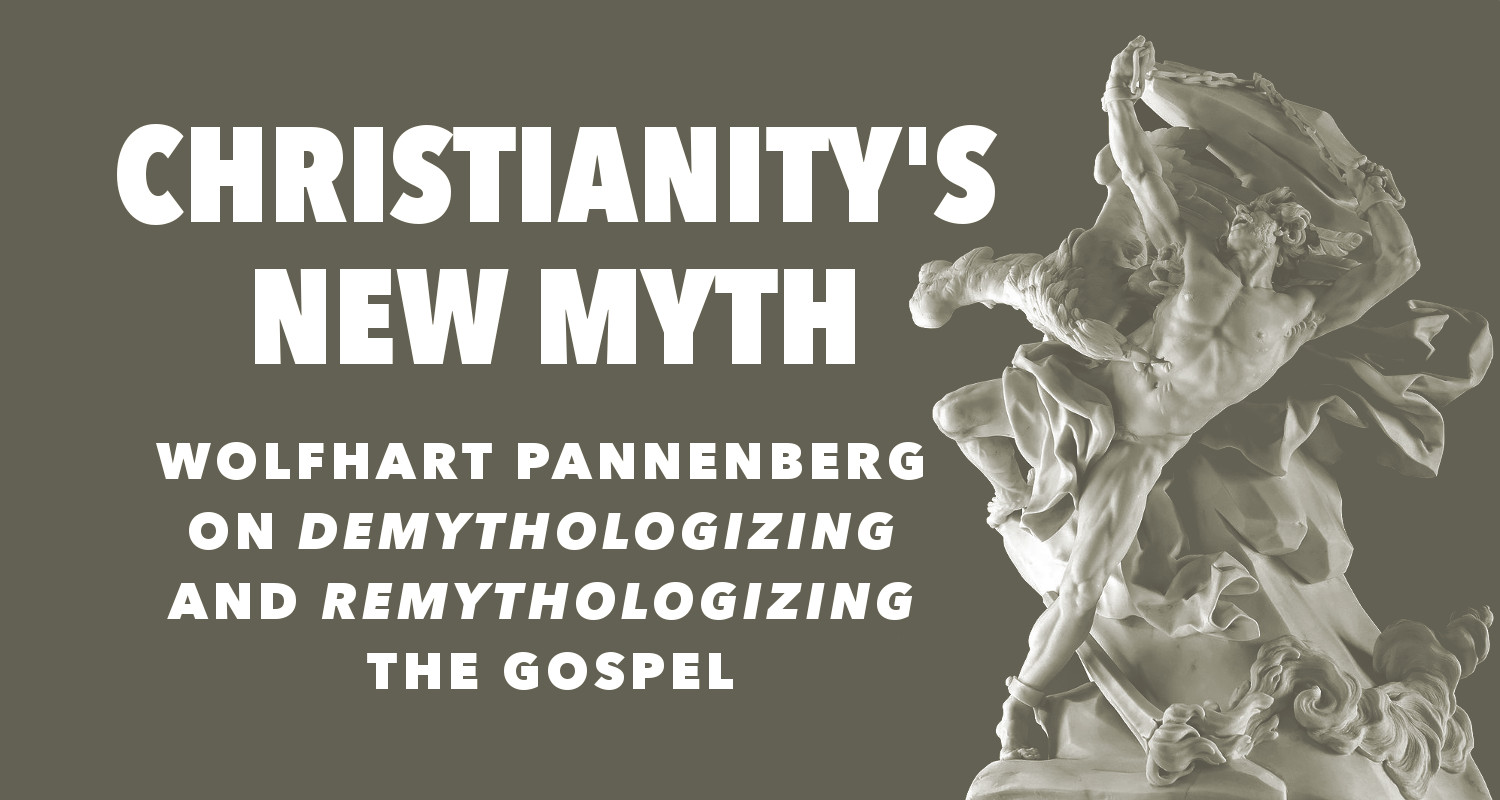
Eye-Witness and Myth
Eye-witness accounts appear throughout the New Testament, but in the latest (and most dubious) New Testament scriptures distinguish themselves as eye-witnesses reports (ἐπόπται) in antithesis to aberrant myths (μύθοις) (c.f. 1 Tim 1:4, 4:7, 2 Tim 4:4, Tit 1:14, 2 Pet 1:16). In Wolfhart Pannenberg's essay "Myth in Biblical and Christian Tradition", he explains that "The view that the Christian message has nothing to do with myth is already found in the later writings of the New Testament" [1]. The earlier New Testament writings contain eye-witness accounts, but do not explicitly set themselves in contradistinction to myths in the same way as these last entries to the biblical canon, such as when "The second epistle of Peter makes a contrast between myths and the preaching of Christ, which is based upon eye witness (2 Pet 1:16)." [2]
Modern scholars have discovered myths in these same late New Testament scriptures and even the earliest New Testament scriptures to the chagrin of these very same New Testament authors and many evangelical scholars today! How then is this rejection of myth in the New Testament reconciled with the presence of myth in the New Testament?
A Demythologizing Gospel
Many modern scholars, following Rudolf Bultmann, Ernst Käsemann, and others have rightly argued that this rejection of myth in the latest New Testament scriptures indicates that the gospel is a program of demythologization, and that the early church desired to free itself from myth of all kinds, and that demythologizing is necessary directive of the gospel. Pannenberg explains "Under the influence of the 'history of religions' school, and especially of the theology of Rudolf Bultmann, it has become fashionable to accept that mythical thought exercised considerable influence on primitive Christianity, and yet to state at the same time that these mythical features are alien to the true spirit of the gospel, so that a 'demythologization' of the New Testament can be regarded as the logical conclusion of the central purpose of early Christianity." [3]
Pannenberg agrees with the need for demythologizing, exemplified by his rejection of the Virgin Birth, but he does not agree that the gospel must be free of all forms of myth like these modern scholars. Today, myth broadly includes fairy tales, fables, saga or other fictional narrative literary forms including new myths such as Rudyard Kipling's just so stories. Pannenberg argues that the New Testament does not myth in this broad definition, nor may myth be reduced and generalized as Greek mythology either. Pannenberg says "This distinction between myths and the preaching of Christ as the truth is not aimed in the first instance against Greek mythology. In fact there is explicit mention of 'Jewish myths' (Titus 1:14)." [4] Pannenberg believes myth (as it is exists in the Bible) may be narrowly defined as a story about the gods from the primal age. Therefore the rejection of myth by these late New Testament scriptures are specifically a rejection of the cleverly devised myths (i.e. stories about gods from the primal age) devised to thwart the gospel, and these scriptures are not broadly myths of each and every form.
Christianity's New Myth
Pannenberg argues that the gospel demythologizes but it also remythologizes by creating a "New Myth" of it's own that is inseparable and indispensable to the church's liturgy and life. As the gospel ejected Hellenistic and Jewish myths, it also injected its own Christian "New Myth". What is Christianity's New Myth? Pannenberg often-quoted famous definition is that "The heart of the Christian 'new myth' is the conception of the redeemer who came down from heaven." [5] Pannenberg explains that many religions that predate Christianity have perpetuated a myth that tells of a god or eternal son of god that comes down from the realm of the gods to redeem humanity. Pannenberg explains that this myth formed a "'ready-made royal cloak' which had only be placed on Jesus' shoulders" [6], which means that when Christians encountered this myth, they proclaimed that the historical Jesus was this mythological son of God who came down from heaven. The Church adopted this myth (among others) as part of it's gospel proclamation, not only in Church history but in the New Testament itself, and Pannenberg says this "interpretation of Jesus as the second or last Adam, who by his righteousness and sacrificial death overcame the sins of the first man and the whole disastrous course of human history" [7].
Christianity's Synchronism with Myth
Pannenberg argues that Christianity's New Myth is necessary to the Church's liturgy and life, and may not be demythologized away. It is entirely appropriate and necessary for Christianity to synchronize with myths that it encounters for the purpose of advancing the gospel, and this has edified the church by establishing many artifacts of its liturgy, such as the Church's gathering on Sunday, because Sunday was previously reserved for worshiping the pagan sun god Sol, but Jesus who is the sun of righteousness is the true light of the world, and therefore the church's commandeering Sunday for the Lord's Day is entirely appropriate. In the same way, myth has been repurposed for celebrating the Resurrection on Easter at the spring solstice, and the birth of Jesus at Christmas on the winter solstice.
The "new myth" of the epiphany of the eternal Son of God in the figure of Jesus of Nazareth formed the starting point in Christian tradition for the adoption of the mythical though forms of Hellenism, which in this way were incorporated into the Christian world. The importance of this process, which goes far beyond the theoretical sphere of theological reflection, can best be seen in the history of Christian Sunday and the development of the Church calendar, which has had a permanent effect upon the way Christianity perceives the connection between liturgy and life. [8]
In this concluding quote, Pannenberg explains that demythologizing is not enough, because the introduction of Christianity's "New Myth" by the gospel, indicates that remythologizing is also an indispensable component of the Church's liturgy and life:
"mythical themes used in this way are by no means merely ornamentation, reflecting the Hellenistic eduction of the church fathers. In the basic content of the theology of the incarnation at least, they are also a necessary element in a reflective consideration of Christian faith. Even in what seem to be only playful allusions to themes and figures of mythical tradition, they therefore represent a meaningful exposition of the significance of the life and ministry of Jesus. And the easy facility in using mythical themes which had long become the material of literature corresponds, in the consciousness of someone like Clement of Alexandria and later representatives of Christian Platonism, to the awareness of the provisional nature of the present life of Christians and therefor of their knowledge of God. This remains symbolic theology in the sense in which the expression is used in the Areopagite; for it possesses the revelation of God only in a concealed form, and to see him face to face is something still to come." [9]
An appendix listing the New Testament scriptures [10] that use the word myth (mythos / μύθοις):
- 1 Timothy 1:4 and not to occupy themselves with myths [μύθοις] and endless genealogies that promote speculations rather than the divine training that is known by faith.
- 1 Timothy 4:7 Have nothing to do with profane myths [μύθους] and old wives’ tales. Train yourself in godliness,
- 2 Timothy 4:4 and will turn away from listening to the truth and wander away to myths [μύθους].
- Titus 1:14 not paying attention to Jewish myths [Ἰουδαϊκοῖς μύθοις] or to commandments of those who reject the truth.
- 2 Peter 1:16 For we did not follow cleverly devised myths [σεσοφισμένοις μύθοις] when we made known to you the power and coming of our Lord Jesus Christ, but we had been eyewitnesses of his majesty.
Sources:
1. Wolfhart Pannenberg, The Idea of God and Human Freedom, "Myth in the Biblical and Christian tradition", p. 1
2. Pannenberg. 1.
3. Pannenberg. 66
4. Pannenberg. 1.
5. Pannenberg. 69.
6. Pannenberg. 67
7. Pannenberg. 73
8. Pannenberg. 75
9. Pannenberg. 79
10. All scriptures quotations are from the New Revised Standard Version
Related: Basic Questions in Theology Vol 3, Christianity's New Myth, Demythologization, Demythologizing, Ernst Käsemann, New Myth, Remythologizing, Rudolf Bultmann, The Idea of God and Human Freedom, Wolfhart Pannenberg



Leave a comment